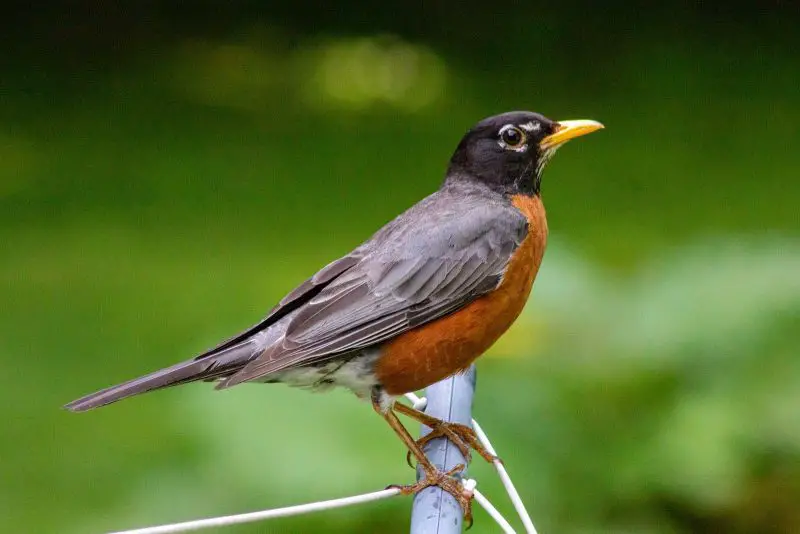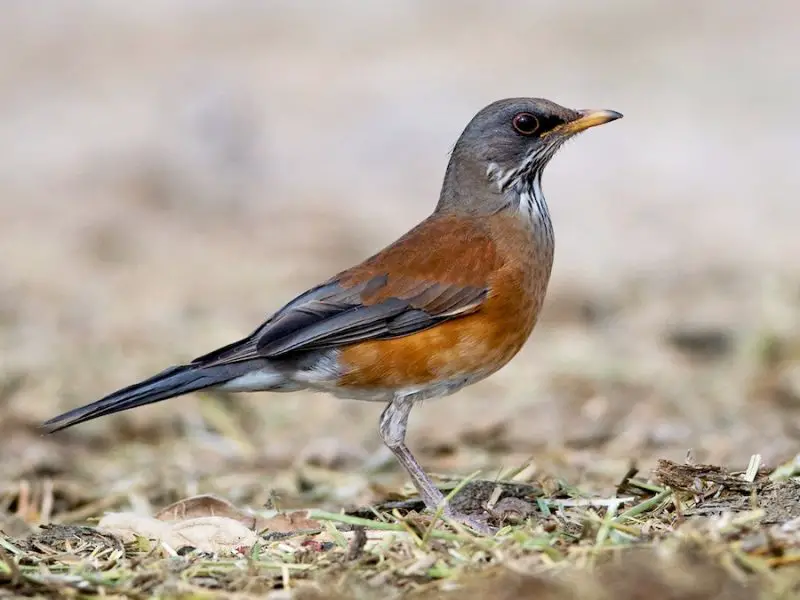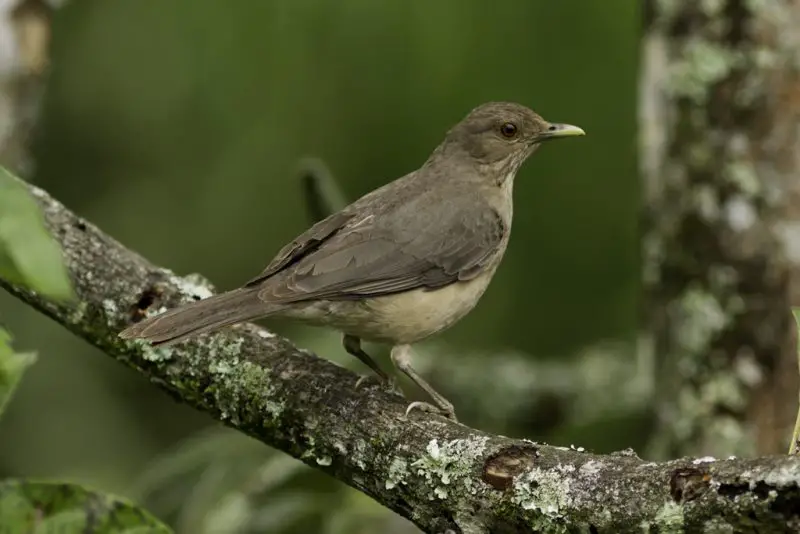Texas is one of the most biodiverse states in the United States, where countless bird species find suitable habitats across deserts, woodlands, grasslands, and wetlands. Among these feathered residents and visitors, the robin stands out as one of the most familiar and recognizable birds. While most people immediately think of the American Robin when the name comes up, Texas is unique because birdwatchers here can encounter more than one type of robin. Thanks to its position along major migratory flyways and its proximity to Mexico and Central America, the state occasionally hosts robin species that are not usually found elsewhere in the country.
When exploring Texas’s backyards, parks, and wild landscapes, bird enthusiasts might come across three distinct types of robins: the American Robin, the Rufous-backed Robin, and the Clay-colored Robin, also known as the Clay-colored Thrush. Each of these species has its own characteristics, habits, and habitat preferences, making them fascinating to study and identify. Understanding their physical features, behaviors, and distributions not only enhances birdwatching experiences but also contributes to the appreciation of Texas’s role as a crossroad for avian diversity.
This article provides a detailed guide to the three types of robins in Texas. You will learn how to identify them, where to look for them, and what makes each species unique. With pictures and descriptions, you’ll be equipped with the knowledge needed to spot these birds in the wild and distinguish one from another.
The American Robin: A Familiar Sight Across Texas

Characteristics and Appearance
The American Robin (Turdus migratorius) is one of the most recognizable and widespread birds in North America. It is a large thrush with a striking reddish-orange breast, a gray-brown back, and a yellow bill. Its eye is accented with a broken white ring, giving it a lively expression. Males often have deeper and brighter coloration than females, while juveniles appear mottled with spots on the chest.
This bird typically measures about 9 to 11 inches in length, with a wingspan of 12 to 16 inches. Its upright posture and energetic movements make it easy to spot on lawns, fields, and forest edges. The American Robin is also well known for its melodious song, which consists of a series of rich, clear phrases often described as cheerful and musical.
Habitat and Behavior
In Texas, the American Robin can be seen throughout much of the year, though its presence varies depending on the region. During migration seasons, large flocks sweep across the state, especially in the fall and spring. While some individuals remain year-round in northern Texas, most populations migrate further south in the winter.
This species adapts well to human-modified landscapes. It thrives in suburbs, parks, and gardens where grassy areas provide opportunities for foraging. American Robins are primarily ground feeders, searching for earthworms, beetles, and insects, but they also eat berries and fruits when available. Their preference for open spaces near trees makes them highly visible in neighborhoods and natural areas alike.
Nesting and Reproduction
The American Robin is an early nester, often beginning in late winter or early spring. Females construct cup-shaped nests made of grass, mud, and twigs, usually placed on tree branches, shrubs, or man-made structures. They typically lay three to five pale blue eggs, which hatch after about two weeks of incubation.
Both parents contribute to feeding the chicks, and the young leave the nest within two weeks after hatching. In Texas’s warmer climate, American Robins may raise multiple broods during a single breeding season. Their nesting behaviors, combined with their adaptable nature, ensure their continued abundance across the state.
Identification in Texas
Spotting an American Robin in Texas is relatively easy due to its bold coloration and widespread distribution. Birdwatchers should look for its bright breast and listen for its distinctive song in the morning and evening. Because it often feeds on the ground in open areas, it is one of the most approachable species for new birdwatchers.
The Rufous-backed Robin: A Rare Visitor from Mexico

Characteristics and Appearance
The Rufous-backed Robin (Turdus rufopalliatus) is a close relative of the American Robin, but it has distinct features that set it apart. True to its name, this bird has a rich rufous or reddish-brown back, wings, and tail. Its underparts are lighter, with a white belly and orange wash across the breast. A streaked throat and pale eye ring also help with identification.
This species is slightly smaller than the American Robin, averaging around 9 inches in length. Its plumage provides excellent camouflage in the wooded habitats it prefers, blending with the reddish tones of dry leaves and bark. While less well-known than its northern cousin, the Rufous-backed Robin is an exciting bird to encounter for those lucky enough to spot it in Texas.
Habitat and Behavior
The natural range of the Rufous-backed Robin extends across western and central Mexico. However, it occasionally strays north into the United States, with sightings recorded in southern Arizona, New Mexico, and Texas. In Texas, it is considered a rare but regular vagrant, often appearing in the Rio Grande Valley and other southern regions.
Its behavior is similar to that of the American Robin. It forages on the ground for insects, fruits, and berries and can often be seen flicking through leaf litter in search of food. The Rufous-backed Robin tends to be more secretive, spending time in thickets and forest understories, which makes it harder to spot than the American Robin.
Nesting and Reproduction
In its core range, this species breeds from late spring through summer. Its nesting habits resemble those of the American Robin, with cup-shaped nests built in trees or shrubs. Females lay three to four pale blue eggs, and both parents care for the young. Because its breeding range only barely touches the southern edges of Texas, confirmed nesting records in the state are extremely rare.
Identification in Texas
For birdwatchers in Texas, identifying a Rufous-backed Robin requires careful observation. Its rufous back and wings are the key features to distinguish it from the American Robin. Birders visiting the Lower Rio Grande Valley should be especially alert, as this is the most likely region to encounter the species. Rare bird alerts often generate excitement whenever a Rufous-backed Robin is spotted, making it a prize find for dedicated enthusiasts.
The Clay-colored Robin: A Tropical Thrush in Texas

Characteristics and Appearance
The Clay-colored Robin (Turdus grayi), also known as the Clay-colored Thrush, is another Central American bird that occasionally reaches Texas. Unlike the American and Rufous-backed Robins, it has a plainer appearance. Its plumage is mostly brown or clay-colored, with a lighter throat streaked with faint lines. It lacks the bold red breast that defines the American Robin, but its simplicity gives it a subtle elegance.
This species measures about 9 inches in length and has a similar body shape to other thrushes. It is not as brightly colored, but it makes up for this with its beautiful voice. The Clay-colored Robin’s song is clear, melodious, and flute-like, often compared to the caroling notes of the American Robin.
Habitat and Behavior
The Clay-colored Robin’s native range stretches from Mexico through Central America to northern South America. In the United States, it is most often recorded in southern Texas, particularly in the Rio Grande Valley. Sightings outside this area are very rare.
This species prefers wooded habitats, gardens, and areas with dense vegetation. Like its relatives, it feeds on insects, fruits, and small invertebrates, often hopping along the ground while foraging. Because of its plain plumage, it can be overlooked, but its distinctive song often reveals its presence.
Nesting and Reproduction
In its typical range, the Clay-colored Robin breeds from March to August. Nests are built in trees or shrubs and are similar in construction to those of the American Robin. Females lay two to four eggs, which are incubated for about two weeks before hatching.
In Texas, there are limited breeding records, but occasional nesting has been observed in the southernmost regions. Its ability to expand slightly into the United States highlights Texas’s role as a gateway between temperate and tropical ecosystems.
Identification in Texas
Identifying the Clay-colored Robin requires attention to detail. Its plain brown coloration, streaked throat, and lack of a red breast are the main distinguishing features. Birders should also listen for its rich, flute-like song, which carries across wooded areas. For those seeking to add this species to their life list, southern Texas is the best place to look.
Quick Identification Guide to Robins in Texas
Robin Species |
Size |
Key Colors |
Typical Habitat in Texas |
Rarity Status |
|---|---|---|---|---|
American Robin (Turdus migratorius) |
9–11 in, wingspan 12–16 in |
Bright orange breast, gray-brown back, yellow bill |
Suburbs, parks, gardens, open woodlands |
Very common and widespread |
Rufous-backed Robin (Turdus rufopalliatus) |
~9 in |
Rufous back and wings, orange breast, white belly, pale eye ring |
Thickets, forest understory, Rio Grande Valley |
Rare visitor from Mexico |
Clay-colored Robin (Turdus grayi) |
~9 in |
Plain clay-brown body, streaked throat, no red breast |
Dense vegetation, gardens, southern Texas woodlands |
Rare, occasional sightings in Rio Grande Valley |
Why Texas Hosts Multiple Types of Robins
Texas’s geographic location makes it a hotspot for bird diversity. The state sits at the intersection of major migratory routes and shares a long border with Mexico, allowing tropical and subtropical species to occasionally move northward. The American Robin thrives across the state as a year-round resident and migratory bird, while the Rufous-backed and Clay-colored Robins appear as visitors from Mexico and beyond.
This overlap of ranges creates unique opportunities for birdwatchers in Texas. Few states can boast the possibility of seeing three different robin species, making Texas an especially rewarding place for avian observation. The mixture of temperate woodlands, deserts, and subtropical forests in the Rio Grande Valley ensures that robins of various origins can find suitable habitats here.
FAQs about Robins in Texas
Are all three types of robins common in Texas?
No, only the American Robin is common and widespread across Texas. The Rufous-backed Robin and Clay-colored Robin are rare visitors, typically found in the southern parts of the state near the Mexican border.
Where is the best place in Texas to see rare robins?
The Lower Rio Grande Valley is the best region to look for Rufous-backed and Clay-colored Robins. This area is known for attracting tropical bird species that occasionally move north from Mexico.
How can I tell the difference between the American Robin and the others?
The American Robin has a bright reddish-orange breast, making it the easiest to identify. The Rufous-backed Robin has a reddish-brown back and wings, while the Clay-colored Robin is plain brown with a streaked throat and no red on its breast.
Do Rufous-backed and Clay-colored Robins breed in Texas?
While the American Robin nests widely across Texas, the Rufous-backed and Clay-colored Robins rarely breed in the state. Most sightings involve wandering individuals rather than established breeding populations.
Conclusion
Texas offers birdwatchers a rare chance to see more than one type of robin within its borders. The American Robin remains the most familiar, a symbol of spring and a year-round resident in many parts of the state. Yet the occasional appearances of the Rufous-backed Robin and the Clay-colored Robin add excitement to birding in Texas, reminding us of the state’s role as a meeting ground for North and Central American species.
Whether you are walking through a suburban park in Dallas, exploring the forests of East Texas, or birding in the rich habitats of the Rio Grande Valley, keep your eyes and ears open. Each type of robin has its own story, and together they highlight the diversity and ecological richness that make Texas one of the most remarkable birding destinations in the United States.






